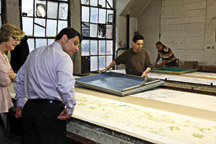It’s the kind of place you might easily miss if you were walking down Jackson Street all the way on Hoboken’s west side. It doesn’t have a hip store window like a mid-century antique shop. But what goes on inside this “mill building” at 38 Jackson is art of the highest order.
Chambord Prints Inc. has been around since the early 1950s. It moved to Hoboken in the 1970s, and Dennis Shah’s family acquired the business in the early 1980s. Shah is company president.
The company manufactures high-end wallpaper for the interior design industry. For example, they sell products to the prestigious Decorator and Design Building in New York City.
In 2005, the company started Studio Printworks, a branded collection of wallpapers and fabrics that they display in designer showrooms.
“Designers like to buy products that match the complete look of a room,” Shah said. “Why not sell them two products, paper and fabrics?”
Indeed.
The company has showrooms in a number of foreign capitals, including Beijing, London, Mumbai, Paris, and Sydney.
“Then-Governor of New Jersey Jon Corzine came to the opening of the Beijing showroom directly from the airport,” Shah said.
“We print by hand. The people and expertise are our machinery.” – Dennis Shah
________
The product
The company’s signature designs are part of its unique Great Contemporary Artists collection featuring the likes of renowned American artist Kiki Smith.
“We were lucky to start out with someone of the stature of Kiki Smith,” said Temo Callahan, design director of the company. “Now we are contacted pretty much every week by artists or their galleries.”
Smith’s “Maiden & Moonflower” design depicts an evening scene beneath a tree bough surrounded by stars.
The artist’s statement says it “addresses spiritual and eternal aspects of human nature, our connection to the universe, yet our solitary journey.”
A far cry from that vegetable medley on grandma’s kitchen wall.
Smith traced the design on to the acetate for the production of the screens.
Shah said that these artists’ wallpaper creations “connect fine contemporary art to the decorative arts.”
A roll of Kiki Smith wallpaper goes for $450. Depending on the room, you’d need three to 10 rolls, according to Shah.
Handmade makes the difference
Designers in the market for fine wallpaper are looking for hand printed works. “We have about 50 people working on and off,” Shah said, including sales reps and others as well as the skilled artisans.
“We print by hand,” he said, mixing colors by eye with no computers and no machines. “The people and tables and expertise are our machinery. That’s what gives the wallpaper its look, its real richness.”
His design team is creating wallpaper that replaces the “historically fussy multicolor flowers of the past.” We wanted “something more,” Shah said, “younger and fresher, yet with historical context.” He cites the example of a “modern damask in a French deco design with updated colors.”
One artist created a “sociopolitical scene with a sense of humor.”
It was a modern twist on an old French tile design which, Shah said, usually “depicted shepherdesses in the fields, women on swings, and boys playing flutes.”
The artist “decided on a modern day suburban scene with little houses on trash day with the modern ritual of putting out the trash on Tuesday over and over again on the wallpaper.”
Shah loves the confluence of the high-end wallpaper with the humorous subject matter. It could be used in a “child’s room or bathroom,” Shah said. “It’s a conversation piece.”
The creative team has pizza Fridays during which they “order Dominos and toss around ideas,” Shah said. “With the likes of Kiki Smith, she’ll come out to Hoboken and sit down and wait for trials to come in.”
Trials are samples. The colors are mixed by hand. “She can pick the color and see how it looks, the shade of blue for example,” Shah said. “It’s very important to get it right.”
In fact, Smith made several trips to Hoboken, and Chambord gave her rolls of the wallpaper which she used to redo her own home and studio.
What’s also in the building
The building on Jackson Street also houses an art gallery, a couple of artists, some importers, and people in the furniture business.
“The area is changing,” Shah said. “Fewer blue collar people and more professionals. We’d like to do a mixed-use project and work with the city in developing it. The hardcore manufacturing would move elsewhere, while design would stay in Hoboken.”
The mixed-use building would house designers, artisans, and artists of all kinds. “It would all work in unison,” he said.
He’s also thinking of opening a retail space, where he would show fabrics.
“It seems like a large number of designers in town are interested in the product,” he said. “That wasn’t the case before.”
He tells a story that has to do with one of their most popular designs – the pineapple motif. “Pineapples are the symbol of prosperity, wealth, welcome, and hospitality,” he said.
“A woman was staying at a hotel in Chicago and saw the pineapple wallpaper and wanted to buy it,” he related. “She tried to hunt it down through the hotel, and they said it was manufactured in Hoboken in our office. It turned out she lived in Hoboken.”
She easily tracked them down. “That’s happening a lot,” Shah said. “The consuming population is opening its eyes and understanding.”
He added, “The wallpaper industry is coming back. The press is picking up stories. We’re putting Hoboken on the map. It’s an interesting and compelling arts location.”
Kate Rounds can be reached at krounds@hudsonreporter.com..
